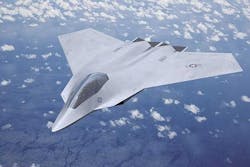GE Aviation developing avionics thermal management for future manned and unmanned aircraft
Officials of the Air Force Research Laboratory at Wright-Patterson Air Force Base, Ohio, are asking GE Aviation experts to continue their work on the Hybrid-Cycle Power and Thermal Management System (PTMS) project as it relates to manned and unmanned aircraft.
GE Aviation will provide additional research in power and thermal management system detailed design. The PTMS project seeks to cool the electronics on future fighter aircraft, which could be at least 10 times more demanding than they are today.
The Air Force Research Lab's Power and Control Division, Mechanical & Thermal Systems Branch are asking GE Aviation for electronics cooling methods that blend air-cycle cooling, vapor-cycle cooling, chilled fuel, and other thermal-energy-storage mechanisms to keep electronics cool on future jet fighters and unmanned aerial vehicles (UAVs).
Related: Keeping cool with hot electronics
Next-generation fighter and unmanned aircraft will require an unprecedented level of advanced capabilities to operate in contested environments, including advanced electronic attack, high-power lasers, and low-observability features, Air Force researchers explain. These systems will require as much as 10 times more power than today's jet fighters and UAVs do.
On these future power-hungry aircraft, thermal management may be an even bigger concern than generating power because electronic component efficiencies and waste heat qualities will be low, researchers say.
Compounding the electronics-cooling problem will be modern jet fighter and UAV design factors like composite aircraft skins, high-efficiency engines, and deeply embedded aircraft systems. Other challenges involve varied duty cycles of power loads on these future aircraft, which on a typical mission can change from continuous to less than 5 percent. This will require a wide thermal management system.
Conventional air cycle systems offer relatively high temperature lifts over comparable vapor cycle systems, yet vapor cycle systems generally are 10 times more efficient at moving heat, which could reduce heat-rejection demands on vehicle thermal sinks.
Vapor cycle systems also could reduce shaft power requirements, and engine-cycle cooling is more efficient than bleed-air-driven air cycle systems. Researchers also are interested in using chilled fuel or other thermal energy storage mechanisms for electronics cooling.
In sum, researchers are asking GE Aviation to provide the ability to use available heat sinks selectively in the most optimal way to ensure sufficient and efficient electronics cooling.
The order announced last week is a modification to a $24 million contract that the Air Force awarded to GE Aviation one year ago for or research in power and thermal management systems detailed design.
For more information contact GE Aviation online at www.geaviation.com, or the Air Force Research Laboratory at www.wpafb.af.mil/afrl.
Learn more: search the Aerospace & Defense Buyer's Guide for companies, new products, press releases, and videos
